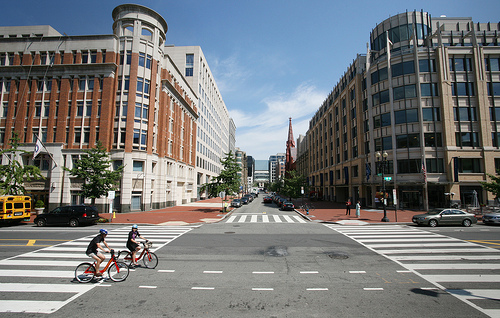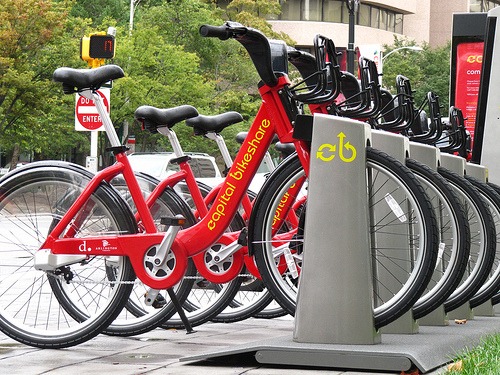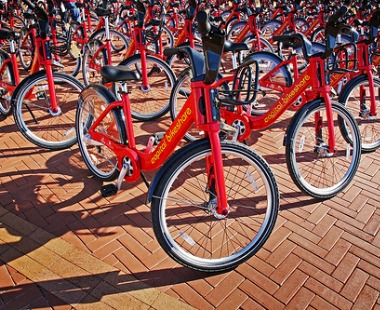 Capital Bikeshare gives you access to 1,100 bicycles around the city.Photo: DDOT DCDo you know what it means to be “dockblocked”? (Don’t worry, that’s a “D,” not a “C,” fellas.)
Capital Bikeshare gives you access to 1,100 bicycles around the city.Photo: DDOT DCDo you know what it means to be “dockblocked”? (Don’t worry, that’s a “D,” not a “C,” fellas.)
If the answer is yes, you are probably a regular user of the Capital Bikeshare system in Washington, D.C. Dockblocked is what you call it when you can’t dock your bikeshare bike because all the spaces are full in the station where you want to stop.
It’s one of very few glitches in a system that has proven popular beyond the hopes of city officials who launched it last fall.
And the fact that CaBi, as Capital Bikeshare is known, has added a new word to the language in Washington is one indicator of how it is changing the way this city thinks about transportation — and has the potential to profoundly change the way people see and experience the city.
A recent essay by Kasey Klimes on Next American City talked about the radically transformative potential of bikes in an urban environment:
Yes, the bicycle is a stunningly efficient machine of transportation, but in the city it is so much more. The bicycle is new vision for the blind man. It is a thrilling tool of communication, an experiential device for the beauty and the ills of the urban context. One cannot turn a blind eye on a bicycle — they must acknowledge their community, all of it …
Invite a motorist for a bike ride through your city and you’ll be cycling with an urbanist by the end of the day. Even the most eloquent of lectures about livable cities and sustainable design can’t compete with the experience from atop a bicycle saddle.
The beauty of bikeshare systems is that they open this experience to a wider range of people. They make bicycles more visible and accessible, integrating them into the larger transportation network.
And so far, D.C.’s is the biggest bikeshare system in the nation.
With some 1,100 bikes at 110 stations around the city, 12,000 annual members, and 4,000-6,000 trips per day in the prime riding season, CaBi has already exceeded expectations for its first year. There have been problems — the question of how to balance the distribution of bikes in the system and prevent dockblocking foremost among them — but so far, according to Chris Holben, bikesharing project manager for the District Department of Transportation, CaBi seems to be bucking the received wisdom that only Europe and Canada can have nice things like this. Theft and vandalism have been only minor irritations, Holben told me.
Increasingly, bikesharing isn’t just for Europeans and Canadians anymore. Minneapolis has a system. Denver has a system. And D.C.’s version is setting the table for Boston (600 bikes coming this summer) and New York (10,000 bikes scheduled to arrive in spring 2012).
I was down in Washington on business the other day and, being a transportation geek of the highest order, was excited to see how it worked.
If you’ve ever paid for gas at the pump with a credit card, renting a bike for a day in Washington isn’t much harder — although at $5, it’s a lot cheaper (annual users pay $75 online and have a “key” sent to them; trips over 30 minutes will add to your tab). Press a touch-screen, swipe your card, get a code, and unlock a bike (more detailed instructions here). The bike itself is solid and heavy and geared forgivingly low. There’s an open basket with a bungee cord to hold your stuff — my big bag just managed to squeeze in but seemed secure once I’d fastened the cord. And then I was off.
I cycled happily along the Potomac and over to Farragut Square, where I decided I wanted to ditch the bike. Problem was, I hadn’t studied the map at the station closely enough (d’oh). And I don’t have a smartphone, so I couldn’t look at the handy free app that shows you not only where the stations are, but how many available spaces and bikes there are at each one (with a lag time of a couple of minutes — another little glitch).
But then I saw another woman on a CaBi bike, and decided just to ask her. She whipped out her phone and told me where the nearest station was, and that there was a spot available there.
Turned out that my Good Samaritan was a woman named Janice Levitt, director of a study-abroad nonprofit called the Alliance for Global Education — and a big bikeshare fan.
“I love it,” she told me. “As a matter of fact, I got memberships for my staff. As long as they use it to commute at least five times a year, we pay for it.”
After we chatted briefly, I cycled to the station she had told me about, rolled the bike into an open dock, and walked away.
I felt almost sinfully free.
 You can find the nearest bike station on your smartphone, if you have one. Or just ask another user. That’s what I did.Photo: James SchwarzAs I continued to go about my business that day, checking out a total of four bikes, I started to see how — even more than owning your own bike — a bikeshare system can make fundamental change happen in a city.
You can find the nearest bike station on your smartphone, if you have one. Or just ask another user. That’s what I did.Photo: James SchwarzAs I continued to go about my business that day, checking out a total of four bikes, I started to see how — even more than owning your own bike — a bikeshare system can make fundamental change happen in a city.
I’ve never lived in Washington, but I have had family and friends to visit there for years. I had always gotten around by a combination of Metro, cab, and walking, and I thought that worked pretty well.
But just one day using the CaBi made me see the place in a whole new way. I was aware of the connections between neighborhoods as I never have been before — able to move faster than on foot, and without the hassle and time of descending to the Metro.
I spoke with Veronica Davis, a planner and engineer who lives in the Hillcrest neighborhood east of the Anacostia River, about her CaBi experience. “It changes how I look at community,” she said. “When I am on the bike, people speak to me and wave at me. When I’m in a car, they can’t see me.”
Davis has her issues with the system. She thinks there should be more stations in her part of town, a subject she wrote about on the blog Greater Greater Washington (a post that caused some controversy).
But in general, she sees it has tremendous potential for changing how many people experience Washington.
Davis recently had a client in town who used the system to get back to his hotel after an evening out. “He was like a little kid, he was so excited,” she told me. “He said, ‘This is dope!'” She pointed out that if he had used the Metro instead, he would have gone from one end of the trip to the other without seeing anything of the city that was in between.
For Lauren Konopacz — who, like Davis, has a bike of her own but also uses CaBi — the system encourages flexibility. She’ll use it to go to work in the morning if there is rain forecast for the afternoon, or to go from place to place when out with friends for the evening.”It really has had a hugely positive impact on the way I get around,” she told me. As for the issue of not finding a bike in a station when she wanted one, or having trouble docking a bike, Konopacz was philosophical. “It’s a bike-sharing system, not a bike-owning system,” she said.
Another thing that struck me: A lot of the bikeshare users I saw were women, famously considered an “indicator species” for a healthy bicycling environment. And a healthy bicycling environment means a healthier city.
All I could think about when I was riding the train back to New York was this: I can’t wait for our bikeshare system to roll out.
Bonus: Watch this video about D.C.’s Bike to Work Day and see CaBi bikes in action.



